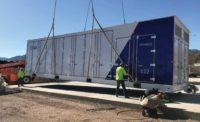Late on April 19, a natural gas well in Bradford County, Pa. blew out and spewed thousands of gallons of drilling waste fluids into local fields, streams and Towanda Creek.
The well blowout occurred during hydrofracking operations at a well operated by Oklahoma City�based Chesapeake Energy around 11:45 p.m. Tuesday evening.
Although the well emitted what Chesapeake is calling “limited amounts of gas,” gas plume modeling performed by both the Bradford County Emergency Management Agency and Chesapeake suggests that “any natural �gas releases will not pose a risk to the area’s public safety,” says Brian Grove, senior director of corporate development at Chesapeake.
The blowout occurred at a time when the practice of hydrualic fracturing is under increased scrutiny, as local groups and environmental organizations cite environmental concerns.
Skip Roupp, deputy director of the Bradford County EMA, said on April 21, that the well “is stable, but not completely controlled.” He said crews were finishing repairs to the berm surrounding the well site, and that Chesapeake had brought in a firm specializing in well containment to kill the well.
The firm, Houston-based Boots and Coots, planned to pump first lost circulation materials such as pieces of plastic and ground-up tires into the well, then heavy mud, to staunch the leak. Another firm was using a vacuum truck and other containment equipment to collect the “very small amount of frac flowback fluid,” still leaking from the well, says Dan Spadoni, spokesman for the Pennsylvania Department of Environmental Protection, North Central Regional Office.
Officials say they don’t know what caused the breach in the well. However, the breach was located in a wellhead connection, and that is where investigators will focus initially, says Grove, adding, “There is no evidence of a downhole casing-failure of any type.
While officials are investigating, the incident, Chesapeake has voluntarily suspended all well-completion operations in Pennsylvania, Grove says.
The PA DEP has several personnel onsite overseeing the well containment operations, as well as individuals collecting environmental samples of water near the well and near home wells. The results of the sample tests are not available yet, Spadoni says.
Spadoni says that although well blowouts typically are a result of “multiple” violations that can result in civil penalties, “first and foremost the focus right now for all parties involved is on killing this well.”




Post a comment to this article
Report Abusive Comment